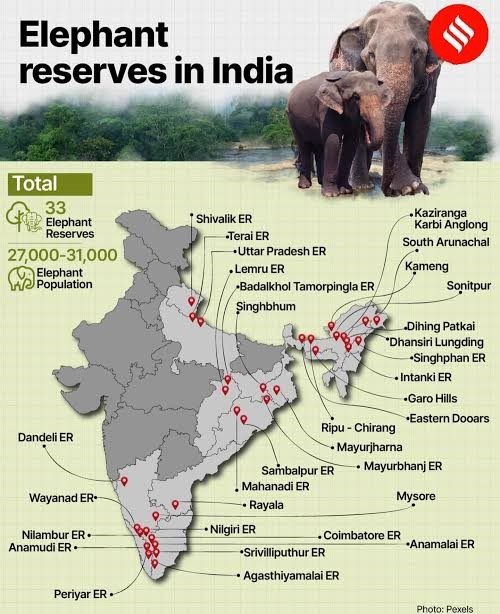Important Facts For Prelims
Elephant Poaching in Tamil Nadu
- 12 Apr 2025
- 5 min read
Why in News?
A recent elephant poaching incident in Tamil Nadu has reignited concerns about the re-emergence of wildlife crime as an existential threat to the survival of wild elephants.
- As per the Ministry of Environment, Forest and Climate Change (MoEFCC), the elephant population dropped from over 4,000 (2012) to <2,800 (2017) but recovered to 3,000+ (2024).
What are the Key Facts About Elephants?
- About:
- Elephant is a National Heritage animal of India.
- They are matriarchal, living in groups led by females.
- They are considered "Keystone Species" for playing a critical role in maintaining the balance and health of forest ecosystems.
- As ecosystem engineers, elephants facilitate seed dispersal and create access to water sources for other species.
- Species:
- Asian Elephants (Elephas maximus)
- African Elephants:
- African Savannah Elephants (Loxodonta africana)
- African Forest Elephants (Loxodonta cyclotis)
- Population in India:
- Indian elephants are a subspecies of Asian elephants native to the Indian subcontinent that represent around 60% of all Asian elephants.
- According to the elephant census conducted in 2017, India is home to approximately 29,964 elephants.
- Karnataka had the highest number of elephants followed by Assam and Kerala.
- In terms of protected areas, Sathyamangalam forest division has the highest number of elephants.
- Threats:
- Ivory trade, human-animal conflict, inter-state and transnational wildlife trafficking, etc.
- Conservation Status:
- Convention of the Migratory Species (CMS): Appendix I
- Wildlife (Protection) Act, 1972: Schedule I
- Related Initiatives:
- India:
- Project Elephant: Launched in 1992 to safeguard elephants and their natural habitat in India.
- Elephant Reserves & Corridors: There are 33 elephant reserves and 150 elephant corridors in the country.
- Project RE-HAB: Aims to prevent elephant-human conflicts by installing bee-fences, thereby minimising both conflicts and retaliatory killings.
- Global:
- World Elephant Day: It is observed annually on 12th August to raise awareness about the urgent need to protect and conserve elephants.
- Monitoring of Illegal Killing of Elephants (MIKE) Programme: It is an international initiative that tracks elephant mortality trends to support conservation efforts in Asia and Africa.
- India:
Difference Between Asian and African Elephants:
|
Feature |
Asian Elephant |
African Elephant |
|
Geographical Range |
|
|
|
Size |
|
|
|
Tusks |
|
|
|
Trunk |
|
|
|
Skin Texture |
|
|
|
Conservation Status (IUCN) |
|
|
Note: Elephant Reserves lack legal protection unless they fall within existing Reserve Forests or Protected Areas.
UPSC Civil Services Examination Previous Year Question (PYQ)
Q. With reference to Indian elephants, consider the following statements: (2020)
- The leader of an elephant group is a female.
- The maximum gestation period can be 22 months.
- An elephant can normally go on calving till the age of 40 years only.
- Among the States in In
- dia, the highest elephant population is in Kerala.
Which of the statements given above is/are correct?
(a) 1 and 2 only
(b) 2 and 4 only
(c) 3 only
(d) 1, 3 and 4 only
Ans: (a)





